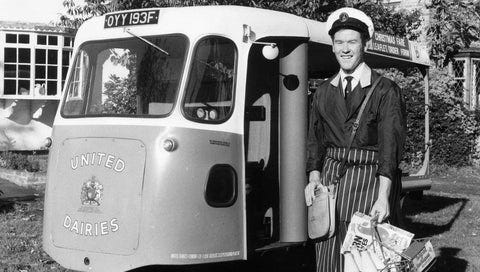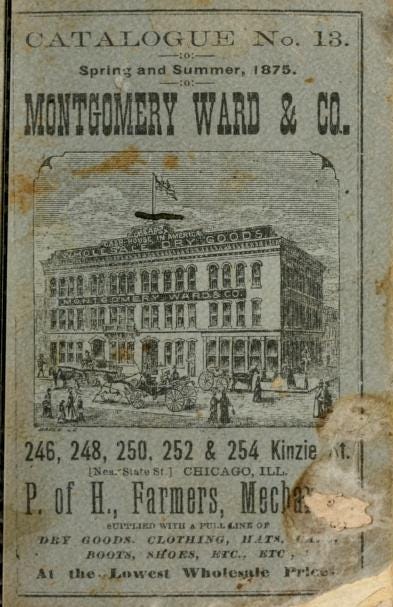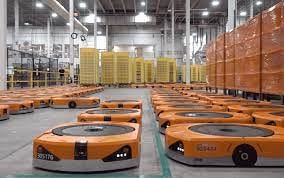Rethink the Customer Journey
Our Roots…
When we talk about DTC, direct-to-consumer, we typically think of ecommerce brands that have cut out the middle man. Instead of a string of distributors and brokers, products are sold directly from the makers to the customers.
You’ve got your Warby Parkers and Allbirds and a million brands in between… all whom started somewhere between 2010 and 2020.
But that is not where it actually started. Warby Parker is just a digital iteration of DTC that is, in fact, nearly as old as the United States.
The first known instance of direct-to-consumer sales started in 1785 in Vermont. There was a milkman who would sell milk from the dairy farmers door to door. He would cart around a barrel of milk, and people would bring out their own jugs to be filled with fresh milk.
Even free delivery was a thing back then…
And from then on, DTC has been a thing. Evolving along the way.
Mail-order Catalogs (Montgomery Ward, Sears Roebuck)
In-home Demos (think Tupperware parties)
Telephone Shopping
Infomercials (but wait there’s more)
the Internet
Warby Parker’s ancestors laid a lot of groundwork for them to be able launch their try-on-in-home model. They were a stellar breakout in ecommerce 10 years ago, and paved the way for many brands to come, but their model is not exactly novel.
If you look back at that list above, what does it tell us?
That customers are thinking up new ways to buy direct? That people got more savvy in their shopping habits over time?
No, of course not. It just shows us that technology has evolved… with the customers in tow.
It also shows us that technology, whether it was the printing press or the pony express, makes it easier for business to sell and buyers to buy.
The customers, you and me and everyone we know, haven’t changed that much. People don’t evolve as fast as technology. We make decisions in the same way we always have.
How we buy might be easier now with our banks attached to our Prime account and robots pick-and-packing orders to be shipped within hours… but overall, we are still human.
Our breakout…
In the 1990s the internet became more accessible to most households, and marketers gobbled up the opportunity to use it for business. From there things moved fast.
Amazon, PayPal, Google, and Facebook all leading the charge and commercializing everything it their path.
Which has been great for the most part. For both businesses who can reach more people, and consumers who have more options and convenience.
For the most part it was around 2010 when buying online gained traction. And over the next 10 years things blew up.
Ads were no longer controlled by agencies. You didn’t need to be a developer to build a website. Every functionality you could imagine was a plug-n-play app.
Ecommerce on speed.
And then the pandemic finally blew the lid off. Everyone hunkered down at home. They were either buying things online like crazy or launching their own DTC brand.
It was a gold rush.
It was fun while it lasted…
Now we come to 2022, the pandemic has largely subsided, and people are out and about again. There purchases are less online shopping and more going out outside. More restaurants and outdoorsy sport stuff.
It doesn’t mean that people stopped buying online, just not in the way they did during the pandemic.
This felt to many ecommerce brands as if someone slammed on the brakes. It was jarring. After 2 years of unreal (literally) growth, things are leveling out.
Everyone knew this would happen deep down. But people were overconfident. And in their own bubble of business, brands thought they were at the helm.
But they weren’t. The customers were.
As they have always been.
Our Opportunity…
Earlier this year, I started hearing a line being passed around the ecommerce circles:
blah blah blah, especially in times of uncertainty
And I probably repeated it or at least thought it. It’s one of those ideas that is seemingly harmless and not really worth arguing against.
But then I started doing these interview for the Sidekicks series. And it was apparent that this line of thinking is kind of an excuse. It is used for business people to pass blame.
It started to sound lazy.
What this line really says is that doing business in the same way we have for the last 10 years is no longer working and I don’t know what to do.
Which is also where the opportunity lies.
You see, most brands echo this sentiment of uncertainty and are at a loss about what to do. Maybe it is because sales are not so strong that they don’t want to try something new. Or there teams are small and specialized and switching things up is easier said than done.
I get that.
But the opportunity is not going to come from initiatives that require a lot of investment or hiring new teams. It comes from doing what has always been central to the sustainability or a business - understanding the customer
Let’s rethink this…
This post is the launch of the Sidekicks series for our podcast and newsletter. And I wanted to start things off on the right foot. Not with hype. Not with platitudes. But with a reset of our marketing minds.
And for that, I called Josh Tay.
On the Podcast, we talked together about his concept of enablement and how to reframe our thinking to create a customer journey that is actually about the customer.
Enablement
The concept of enablement is simple - how can we make it easier for the customer to buy and to use the product.
Simple does not mean easy. It requires truly understanding your customers, and being able to distill your message in a way that they can comprehend with ease.
But if you don’t understand your customer and what they are looking for, it is impossible.
In our conversation, he had an interesting example:
Medicube is a skin car brand from Korea. It is a brand that he uses and trusts. And he walks through why he was attracted to them. And how they meticulously explain their products, the science behind it, remove objections, and, essentially, make it easier for him to make his first purchase.
That is enablement in a nutshell.
I checked out the Medicube website. And yeah… it is impressive the lengths they go to on their product pages to cover everything.
As Josh put it:
Basically, everything to overcome my objections. So by this point, I am pretty much convinced, That itself is buyer enablement. It is enabling me to buy better because now I don’t have to ask these questions and go elsewhere to do my research.
I was going to post a screen shot of one of their product pages, but they are too long. In a good way… Check it out.
By understanding the customer and communicating their message clearly, they have broken in to the international market.
To reiterate, the reason for such incredible growth is not from some secret magical marketing strategy… it is from understanding the customer and communicating their message clearly.
Listen to the full episode here.
No time like the present…
Ecommerce is ripe with opportunity, and the brands that see the opportunity and act are the ones that will get ahead… leaving their competitors to fumble with uncertainty.
And no reason to go it alone. We launched a community so you always have a place to go for ideas and advice so you never get stuck wondering what to do next.
Good luck out there!








![[Salicylic Acid Body Cleanser] Red Body Wash (+Gift) - medicube.us [Salicylic Acid Body Cleanser] Red Body Wash (+Gift) - medicube.us](https://substackcdn.com/image/fetch/$s_!NFfL!,w_1456,c_limit,f_auto,q_auto:good,fl_progressive:steep/https%3A%2F%2Fbucketeer-e05bbc84-baa3-437e-9518-adb32be77984.s3.amazonaws.com%2Fpublic%2Fimages%2Faca288d4-d28f-4268-8130-2695564c29b1_250x250.jpeg)